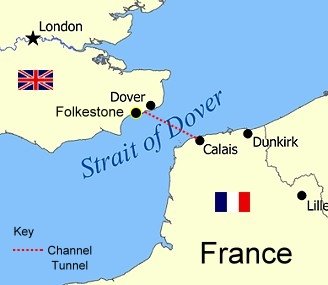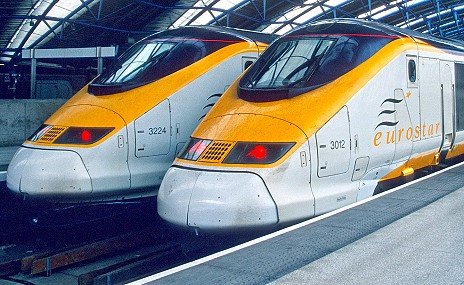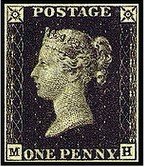Special Days Every Month
Celebrate and learn about special days
every day of the year!
|
Channel Tunnel
" Le tunnel sous la Manche". |
||
|
What is the Channel Tunnel? The Channel Tunnel is the longest undersea tunnel in the world. The section under the sea is 38km long and the entire length is 31.4 mile (50.5-kilometre). At its lowest point it is 75 metres (250 ft) deep. The Channel Tunnel links Folkestone, Kent in England with Coquelles, Pas-de-Calais near Calais in northern France beneath the English Channel at the Strait of Dover.
The Channel Tunnel comprises of three tunnels, each 50km long. There are two single-track rail tunnels, and a third smaller service tunnel. The service tunnel allows access to maintenance and emergency rescue teams and serves as a safe haven if passengers need to be evacuated in an incident. The service tunnel is a road tunnel used by electric and diesel-powered vehicles. The two single-track rail tunnels carries high-speed Eurostar passenger trains, Eurotunnel Shuttle drive-on/drive-off vehicle transport and international rail freight trains.
When was the Channel Tunnel built? Work on the Channel Tunnel started on 15 December 1987 with the boring of the service tunnel on the UK side. In 28 February 1988, boring of the service tunnel started on the French side. First Landlink for 8,000 years Who runs the Channel Tunnel? The company Eurotunnel operates the Channel Tunnel. Will a road tunnel ever be built between Britain and France? Technology has improved so much that it could now be possible to consider a larger bore drive-through tunnel for cars, but not for lorries as they emit too much fumes. Links Dover Castle Also on this day ….
6 May 1954: Roger Bannister ran a mile in less than four minutes.
|
See Teaching Resources for today’s date
Back to Facts of the Day Calendar
Jan | Feb | Mar | Apr | May | Jun | Jul | Aug | Sept | Oct | Nov | Dec
 © Copyright – please read © Copyright – please read All the materials on these pages are free for homework and classroom use only. You may not redistribute, sell or place the content of this page on any other website or blog without written permission from the . projectbritain.com | primaryhomeworkhelp.co.uk |
© Copyright 2013
is the creator of the Woodlands Resources section of the Woodlands Junior website.
The two websites projectbritain.com and primaryhomeworkhelp.co.uk
are the new homes for the Woodlands Resources.
left Woodlands in 2003 to work in Kent schools as an ICT Consulatant.
She now teaches computers at The Granville School and St. John’s Primary School in Sevenoaks Kent.
Woodlands Junior Homework Help new website
born on this day what happened on this day famous birthdays interesting facts did you know Interesting Calendar Facts.








